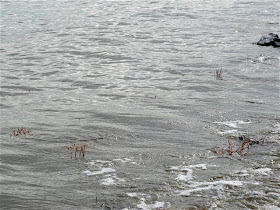On the last of our six-day consecutive field trip series, Ria and I visited a natural rocky shore of Changi to check if the recent sponge-less situation at Chek Jawa and Pulau Sekudu has also affected the mainland shores.
We were glad to have escaped the Sumatra squall that passed Singapore earlier in the morning and thus was able to continue with our survey on the rocky shore.
The Melted chocolate sponges (Chondrilla australiensis) coated many of the rocks at the lower shore with occasional "sprinkles" of other types of sponges. There are also many hydroids in the waters.
Here's a look at the extent of the Melted chocolate sponge covering the rocks with the Straits of Johor and Pulau Ubin at the background.
Other than the encrusting and tiny bits of sponges, the whole shore looks rather barren. Once again, what is sorely missed would be the Purple branching sponges (Callyspongia sp.) and the blue Elegant branching sponge (Haliclona sp.). These branching sponges used to literally infest many of the rocks in the past and we thought that they do very well despite the murky conditions.
There was a spot with these ball-like sponges with spikes grown over thrash on the shore.
Growing on the ropes are some growths of various kinds of colourful sponges though not as much as in the past.
Sometimes mistaken as sponges, these are what we believe as ascidians which are commonly found on Changi, Ubin and Punggol.
Almost on every trip here, we will see the Hypselodoris nudibranch (Hypselodoris sp.). I only found one today though and it was found feeding on an ascidian!
An interesting sighting while checking the underneath of rocks will be this Sea toad spider crab (Schizophrys sp.). They have long pointed heads and skinny legs and are masters of camouflage.
What else can we find under the rocks? Lots! Like this pair of snapping shrimps which I only usually see on Changi rocky shore.
There was a rock where I found several of these tiny anemones which I have not seen before.
Ok, what can you find here? Is there anything? There are actually two Armoured sea cucumbers.
They are indeed very well camouflaged with the environment and thus are
easily overlooked.
The armoured sea cucumber has a very hard body and a very flat base. This is how it looks like with the silt washed
off from its body. Don't you think it looks a lot better?
This tiny sea pen-lookalike may not be a sea pen after all and it could be some kind of soft coral!
Only one Thorny sea urchin (Prionodidaris sp.) was found near the rocks. On our mainland shores, we don't see them as often as the remote shores such as Beting Bronok.
Being an echinoderm lover, I was glad to find three Feather stars (Order Comatulida)! This particular one has both black and white arms and yellow fringes! Pretty!
The Maroon stone crab (Menippe rumphii) looks like the red version of the Thunder crab (Myomenippe hardwickii) though the former is less commonly sighted.
This small hermit crab hiding in the shell of a snail is the 'Blue-orange' banded hermit crab (Pseudopaguristes monoporus). The eye stalks are banded orange-bright blue-orange!
On one part of the shore lies plenty of encrusted Zebra corals (Oulastrea crispata), in fact a lot more than our previous trip here last year.
Another pleasant surprise would be the lush growth of the uncommon Hairy spoon seagrass (Halophila decipiens).
There are many Sea fans (Order Gorgonacea) at the low water level mark! Such as this large one!
As the tide was not super low, they are not really visible with the murky waters. But can you spot the tips of the sea fans on the surface of the water?
At the end of our survey, I quickly walked over to another stretch and found even more tips of the sea fans on the edge.
The smaller ones are more exposed than the larger sea fans. Here are two of different colours.
I'm not sure if I can find a lower enough tide to come back and look at the sea fans. Too many shore and too few super low tides. Nevertheless, looking forward to the next series in July! Meanwhile, time to recover from the jet-lag feel of having to wake up so early in the mornings.

























No comments:
Post a Comment